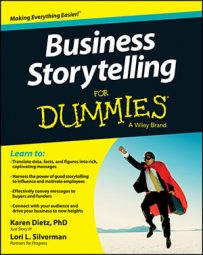One single story (or meta-story) can never fully reflect all of your business. In fact, a meta-story consists of a whole host of smaller stories. If you work in branding, your role is to first recognize that all these stories coexist side-by-side — and then manage the dynamic and informing that happens between the meta-story and these smaller stories.
What's one way to connect story in marketing to branding? A story brief is a way to align stories associated with a brand to story-based initiatives in marketing. Because it includes the challenge marketing faces, which must be solved, along with an assessment of the opportunities available, the story brief becomes marketing's back story and can serve as input to marketing tactics.
Here's a high-level overview for putting together a story brief:
Articulate how the organization's brand is characterized through its persona and active archetypes.
Include brand values and its belief system — what the brand stands for. Do a reality check to make sure that the organization actually walks its talk in the marketplace and that the brand values match the organizational culture.
Add consumer personas that represent the market segments served by the organization.
Include customer, consumer, client, and/or partner needs, problems and challenges, and the conflicts creating obstacles for them.
Also list any universal needs and ideals operating in their lives, like the search for meaning, redemption, or belonging — and articulate the beliefs that are shared between you and these stakeholders.
Connect the dots between the results of steps 1 and 2.
Look not only for needs and ideals that can be fulfilled by your organization's offerings, but also at beliefs, attitudes, and worldviews you also share. Dig deeper into the stories captured in steps 1 and 2 to identify these items. You'll miss the target if you take shortcuts here.
Articulate marketing obstacles more fully.
These obstacles fall into four basic categories:
Are these stakeholders even aware of your enterprise?
Do they comprehend what the enterprise stands for and what it has to offer?
Do they have enough confidence in your organization for them to buy?
Do they have a close affinity with your enterprise that will lead to ongoing relationship?
Find and share stories about these obstacles to better understand the context behind them.
Prioritize and summarize the obstacles and state the actions to be taken.
Finding methods and resources around these obstacles needs to be embedded in marketing's story-based tactical steps. By conducting a more storied situational analysis, you'll end up with deeper, richer, and more accurate information.
Here's a cautionary tale about business storytelling: It seems a fairly large company wanted to get its meta-story down pat — the one story that it would be known for. Someone hired a consulting group that went high and low throughout the organization to collect a boatload of stories from staff.
Afterward, the consultants returned to their offices, studied all the stories, did a wonderful analysis, and generated the company's meta-story. They came back to share it with company executives. Everyone agreed it was a good one. With much fanfare, together they rolled out this wonderful meta-story to all the staff.
The reaction was swift and ugly. Staff turned to each other and said, "That's not the story I told them." Or, "Where did that story come from? Doesn't sound like our story at all."
The problem was that people couldn't see themselves in this rarefied meta-story. That's not the worst of it. Staff felt betrayed by the entire experience. Once they'd been excited to share their stories, believing their voices were being heard. Now they felt invalidated. They'd been given a story that was totally disconnected from what they held to be true and valued. The inside joke became, "Oh yeah. We've been storied!"
So how do you recover from a situation like that? Develop a story brief.

